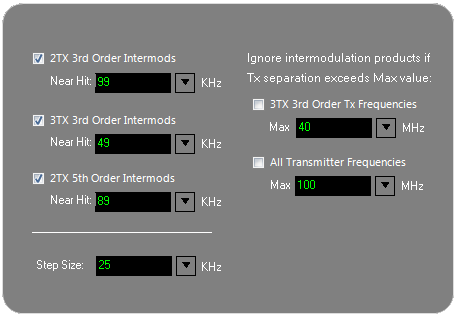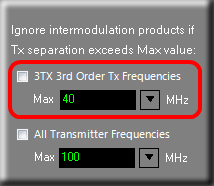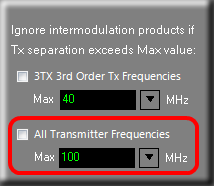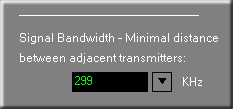
When performing intermodulation calculations there are several settings that affect the size and stringency of the resulting frequency set. These include the following:
Intermod Stringency / Compatibility Level

Pro Audio White Space Finder calculates the 3 types of intermodulation products that happen to be closest to our fundamental frequencies. These are:
When creating an intermodulation-compatible frequency set any combination of these 3 tests can be applied in order to obtain the desired level of reliability. In fact, these three tests can be combined in different ways in order to generate frequency sets with 7 different levels of stringency:
Intermod Products That Are Tested When The Frequency Set Is Generated
Stringency |
2Tx 3rds |
3Tx 3rds |
2Tx 5ths |
Strictest |
YES |
YES |
YES |
Strict |
YES |
YES |
|
Moderate |
YES |
YES |
|
Lenient |
YES |
||
Weak |
YES |
YES |
|
Weaker |
YES |
||
Weakest |
YES |
What this means is that a frequency set created under 'Strictest' conditions is guaranteed to be free of intermodulation interference caused by 2Tx 3rd, 3Tx 3rd and 2Tx 5th intermodulation products. Similarly, a frequency set created under 'Strict' conditions is guaranteed to be free of intermodulation interference caused by 2Tx 3rd and 3Tx 3rd intermodulation products. And so on...
Ideally one would always want to use a frequency set created under 'Strictest' conditions because the frequencies within the set could be assigned to different transmitters and the level of reliability would be very high (since interference caused by intermodulation distortion would be eliminated for all intents and purposes). However, for practical purposes, it may not be possible to always create frequency sets of 'Strictest' stringency when you have many transmitters you need to assign channels to. Assuming that transmitter channels fall on 25 KHz boundaries, then for a particular frequency range (e.g. 470 MHz - 500 MHz) there are a limited number of intermodulation-free frequencies that can be computed. Furthermore, as the stringency is increased then the number of intermodulation-free frequencies that are available goes down. That is, the size of the frequency set is determined by (a) the frequency range, and (b) the intermod stringency or compatibility level.
For example -- let's take the frequency range of 470 MHz - 500 MHz and assume that transmitter channels fall on 25 KHz boundaries. The following results are approximations:
Stringency |
Frequency Set Size |
Strictest |
16 |
Strict |
17 |
Moderate |
22 |
Lenient |
32 |
As you can see, the number of transmitter channels you require will dictate the level of intermod stringency that can be applied in order to generate a frequency set of sufficient size to accommodate your needs. In this example, if we required 26 channel assignments then we would create a frequency set of "Lenient" stringency.
As a side note, when it comes to configuring audio equipment, at the very least your frequency set should be free of interference from 2Tx 3rd-order intermod products -- i.e. be of "Lenient" stringency or higher -- since these are the most destructive.
Near Hit Settings:
Related to 'Stringency' is the concept of 'Near Hits'. This means that in order to qualify as a compatible frequency and be a member of a frequency set a candidate frequency must not match an intermod product nor be within a specified distance of an intermod product. A 'Near Hit' setting specifies the minimum distance a candidate frequency must be from an intermod product in order to qualify as a compatible frequency. If a candidate frequency is too close to an intermod product then it is disqualified. For example, by default, intermod-compatible frequencies must be at least 99 KHz from 2Tx 3rd-order products, 49 KHz from 3Tx 3rd-order products, and 89 KHz from 2Tx 5th-order products. As the 'Near Hit' distance is increased then the frequency set becomes more stringent, but that comes at a cost -- fewer candidate frequencies will qualify as members of the frequency set and, hence, the frequency set will be smaller. We suggest you leave the 'Near Hit' settings at their default values.
Step Size

Most audio transmitters are designed to operate on channel frequencies that fall on 25 KHz boundaries -- i.e. they are "tunable" in 25 KHz steps. Given a frequency range (e.g. 470 MHz to 500 MHz) and a step-size of 25 KHz, then only frequencies within that range and which also are multiples of 25 KHz are potential candidates to be included in the frequency set that Pro Audio White Space Finder generates (provided they also meet the stringency requirements described above). We suggest you leave the 'Step Size' setting at its default value of 25 KHz.
Ignore Certain Intermod Products

Intermodulation products are calculated from either two transmitter frequencies (e.g. 2Tx 3rds, 2Tx 5ths) or three transmitter frequencies (3Tx 3rds). If you prefer that Pro Audio White Space Finder ignore 3Tx 3rd products generated by 3 frequencies where at least one of them is more than 40 MHz distant from the others, then enable this setting by checking the CheckBox. By checking the CheckBox you are telling Pro Audio White Space Finder to ignore certain intermodulation products, thereby decreasing the stringency of the frequency set.

Likewise, if you prefer that Pro Audio White Space Finder ignore any product where at least one of the transmitter frequencies is more than 100 MHz distant from the other(s), then enable this setting by checking the CheckBox. Again, by checking the CheckBox you are telling Pro Audio White Space Finder to ignore certain intermodulation products, thereby decreasing the stringency of the frequency set.
By default Pro Audio White Space Finder does not ignore any intermod products when generating a compatible frequency set. However, if you find yourself in a situation where you need to slightly increase the size of a frequency set, then you might consider checking one or both of these CheckBoxes. Interference from intermodulation distortion may be less of a problem when transmitters are operating in bands that are many MHz apart from one another.
Signal Bandwidth

This parameter controls the minimal distance between adjacent frequencies in the resultant frequency set that is computed. From a practical standpoint the distance between adjacent channel assignments should be sufficient to ensure transmitters do not interfere with one another. The recommended, default value of 299 KHz is on the conservative side. It is important to note this value has a direct bearing on the final size of the frequency set. The larger the signal bandwidth, the less chance adjacent transmitters will interfere with one another -- but the smaller will be the frequency set. The smaller the signal bandwidth, the greater the chance adjacent transmitters will interfere with one another -- but the larger will be the frequency set. So, if you need more channels then experiment with decreasing the size of the signal bandwidth. On the other hand, if you do not require lots of channels then you can use the default value or even increase that if you wish.